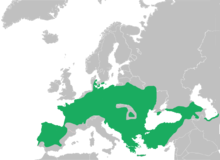Hyla arborea
| European tree frog | |
|---|---|
 |
|
| Scientific classification | |
| Kingdom: | Animalia |
| Phylum: | Chordata |
| Class: | Amphibia |
| Order: | Anura |
| Family: | Hylidae |
| Genus: | Hyla |
| Species: | H. arborea |
| Binomial name | |
|
Hyla arborea (Linnaeus, 1758) |
|
 |
|
The European tree frog (Hyla arborea formerly Rana arborea) is a small tree frog found in Europe, Asia and part of Africa. Based on molecular genetic and other data, a number of taxa formerly treated as subspecies of H. arborea are now generally recognized as full species.
European tree frogs are small; males range from 32–43 mm (1.3–1.7 in) in length, and females range from 40–50 mm (1.6–2.0 in) in length. They are slender, with long legs. Their dorsal skin is smooth, while their ventral skin is granular. Their dorsal skin can be green, gray, or tan depending on the temperature, humidity, or their mood. Their ventral skin is a whitish color, and the dorsal and ventral skin is separated by a dark brown lateral stripe from the eyes to the groin. Females have white throats, while males have golden brown throats with large (folded) vocal sacs. The head of H. arborea is rounded, the lip drops strongly, the pupil has the shape of a horizontal ellipse, and the tympanum is clearly recognizable. The discs on the frog's toes, which it uses to climb trees and hedges, is a characteristic feature of H. arborea . Like other frogs, their hind legs are much larger and stronger than the fore legs, enabling the frogs to jump rapidly.
Members of the H. arborea species complex are the only representatives of the widespread tree frog family (Hylidae) indigenous to mainland Europe. and are found across most of Europe (except Ireland), northwest Africa, and temperate Asia to Japan. This species complex is native to these countries:
Albania; Armenia; Austria; Azerbaijan; Belarus; Belgium; Bosnia and Herzegovina; Bulgaria; Croatia; Cyprus; the Czech Republic; Denmark; France; Georgia; Germany; Greece; Hungary; Israel (found in the Ayalon Valley); Italy; Liechtenstein; Lithuania; Luxembourg; Macedonia, the Republic of; Moldova; Montenegro; the Netherlands; Poland; Portugal; Romania; the Russian Federation; Serbia; Slovakia; Slovenia; Sweden; Switzerland; Turkey; Ukraine.
It has also been introduced to the United Kingdom, and it has been reintroduced to Latvia.
European tree frogs can be found in marshlands, damp meadows, reed beds, parks, gardens, vineyards, orchards, stream banks, lakeshores, or humid or dry forests. They tend to avoid dark or thick forests, and they are able to tolerate some periods of dryness; therefore, sometimes they are found in dry habitats.
...
Wikipedia

